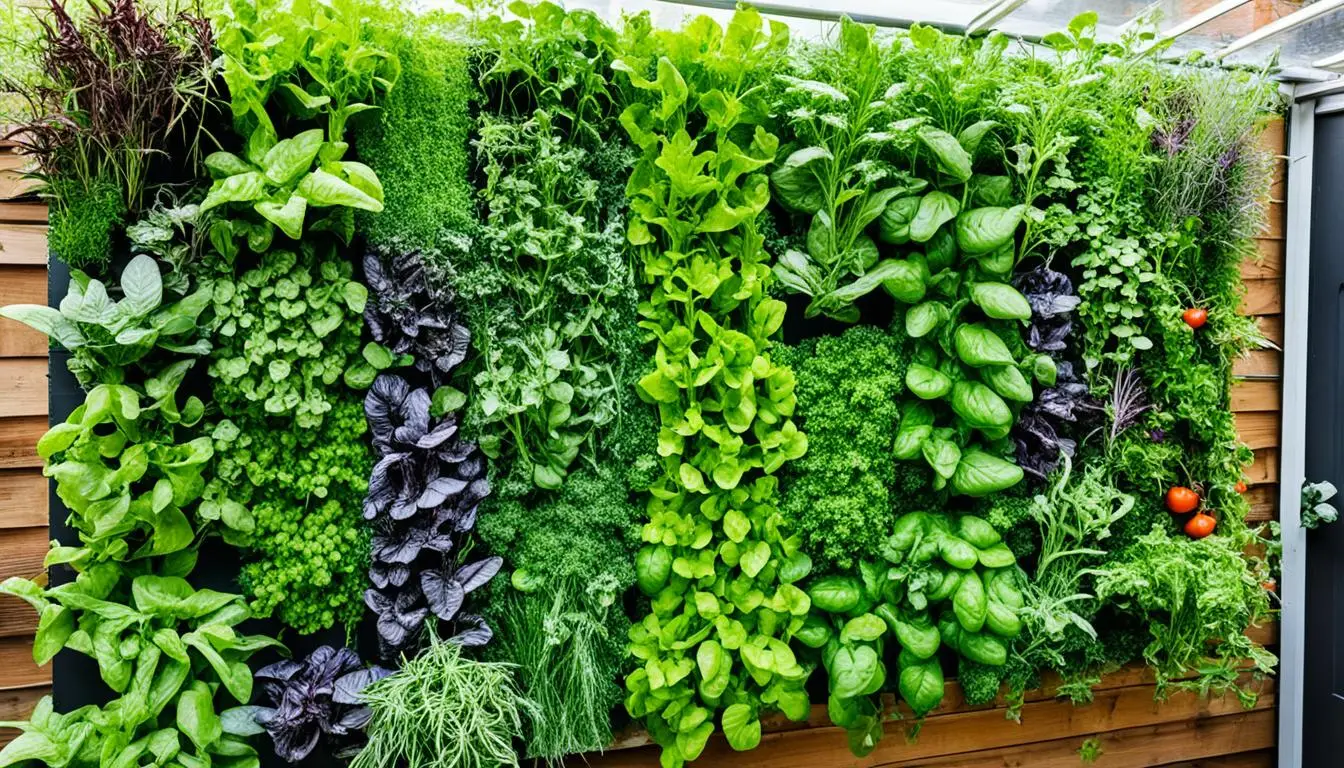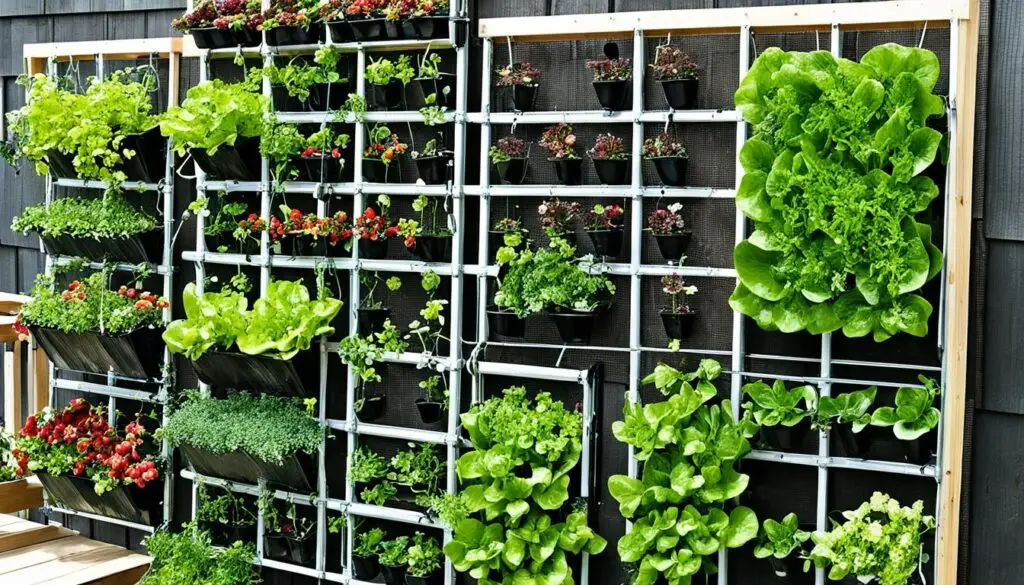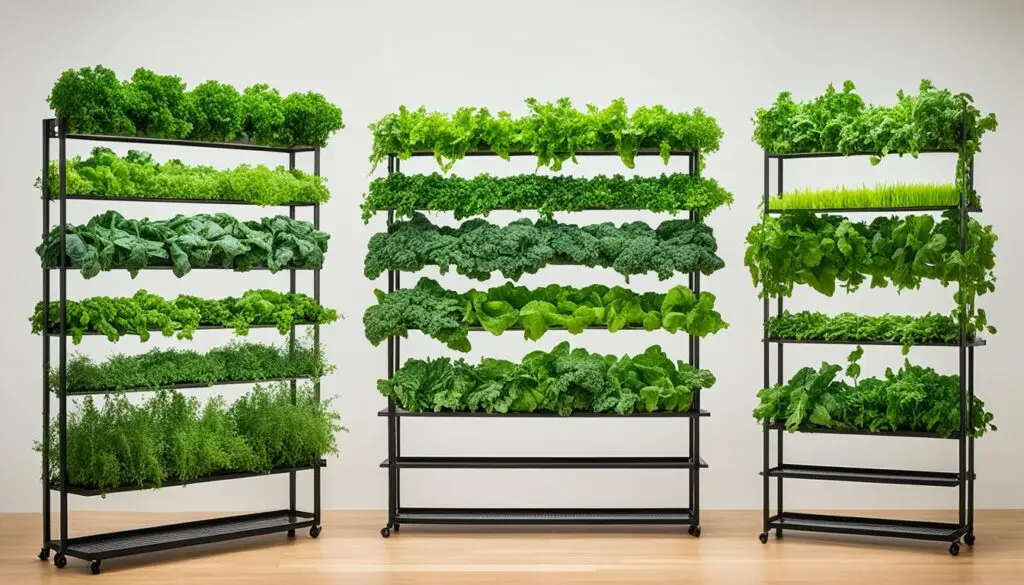Do you dream of having a lush garden but feel your space is too small? Don’t worry, vertical gardening can help. Mark Ridsdill Smith, an expert in urban gardening, shares his tips for making the most of your space. He shows how to turn a tiny balcony, patio, or windowsill into a garden full of fresh greens and herbs.
Vertical gardening uses the space above your head to grow plants. This is perfect for small living spaces like apartments or condos. With smart strategies and new planting systems, you can grow many types of salad greens and herbs. This way, you save space and always have fresh produce.
Key Takeaways
- Vertical gardening is an efficient way to grow a salad garden in small spaces
- Utilize vertical structures like salad towers, hanging baskets, and pallet gardens to maximize limited space
- Select the right salad greens and herbs that thrive in the available sunlight and conditions
- Implement proper watering and fertilizing techniques to ensure a bountiful vertical salad garden
- Get creative with window boxes, wall planters, and other innovative vertical gardening solutions
Introduction to Vertical Gardening in Small Spaces
As cities grow, we need new ways to garden in small spaces. Vertical gardening is a great solution for those with little room. It lets you grow plants up instead of out, saving space and offering many benefits.
Benefits of Vertical Gardening for Small Spaces
Vertical gardening systems like salad towers and hanging baskets have many perks. They let you grow more in a small area, making the most of your space. These gardens also have better pest control and use sunlight more efficiently, helping plants grow strong.
Overcoming the Challenges of Limited Space
Vertical gardening has its challenges, especially in small spaces. Finding enough soil, water, and sunlight can be tough. But, there are ways to beat these issues. Hydroponic gardening and microgreens are great for small spaces and need little soil. Salad towers and vertical planters help you grow lots of salad greens and herbs in a small area.
| Vertical Gardening Technique | Benefits | Challenges |
|---|---|---|
| Salad Tower | – Maximizes growing space in small areas – Efficient use of vertical space – Allows for a variety of salad greens and herbs |
– May require additional support or anchoring – Needs careful watering and nutrient management |
| Hanging Baskets | – Utilizes vertical space above the ground – Suitable for trailing or cascading plants – Can be placed in areas with limited floor space |
– May require more frequent watering – Can be prone to drying out if not monitored |
By using vertical gardening and smart techniques, gardeners with small spaces can have a thriving garden. Even in busy cities, you can enjoy a productive garden.
Choosing the Right Vertical Gardening System
Choosing the right system for a small space vertical salad garden is key. There are many options, from affordable salad towers to hanging baskets. Each one can help you grow more in less space.
Salad Tower: A Space-Saving Solution
The salad tower is a top pick for vertical gardeners. Made from strong wire mesh and plastic, they’re compact and efficient. They save space while giving you lots of room to grow salad greens.
Hanging Baskets: Maximize Vertical Space
Hanging baskets are great for small spaces too. They let you grow things like strawberries or small tomatoes without using the ground. You can hang them anywhere, making the most of your space.
Choosing the right system, like a salad tower or hanging baskets, lets gardeners grow a lot in little space. These solutions are practical and efficient. They help you enjoy a full hydroponic or aeroponic salad garden at home.
“How to Grow a Vertical Salad Garden in a Small Space”
For city folks and those with little outdoor area, starting a garden might seem hard. But, vertical gardening can turn even the tiniest spots into a lush spot for organic produce and indoor gardening.
A vertical salad garden is a great choice for those into sustainable living. It lets you grow lots of salad greens and herbs in a small, vertical space.
Selecting the Right Vertical Gardening System
Choosing the right system for your vertical salad garden is key. Here are some top picks for your space and needs:
- Salad Tower: A modular, stackable planter system that allows you to grow multiple tiers of greens and herbs in a compact, vertical design.
- Hanging Baskets: Suspend a series of baskets or planters from a sturdy support structure to create a cascading vertical garden.
Constructing Your Vertical Salad Garden
After picking your system, start building your garden. Here’s how:
- Follow the maker’s instructions to put together your vertical gardening system, making sure it’s stable and secure.
- Fill the planters or tiers with a good potting mix made for containers.
- Pick a mix of salad greens and herbs that do well in containers and vertical gardens, like lettuce, spinach, kale, and basil.
- Plant your greens and herbs, following the spacing advice for the best growth.
- Keep up with regular watering and feeding to keep your garden healthy.
By doing these steps, you can make even the smallest area into a vibrant vertical salad garden. This way, you can enjoy the perks of sustainable living and organic produce at home.
| Vertical Gardening System | Advantages | Disadvantages |
|---|---|---|
| Salad Tower |
|
|
| Hanging Baskets |
|
|
“Vertical gardening is the key to unlocking the potential of small spaces and bringing the joy of sustainable living to urban dwellers.” – Sarah Johnson, Urban Gardening Expert
Planting and Caring for Your Vertical Salad Garden
Starting a vertical salad garden means picking the right salad greens and herbs. Choose cut-and-come-again lettuce for a steady harvest all season. Add spinach, arugula, and kale for more variety in your vertical garden.
Selecting Suitable Salad Greens and Herbs
For small gardens, pick plants that do well in vertical gardens. Great choices include:
- Loose-leaf lettuce: Varieties like mesclun, red oak leaf, and green leaf lettuce are perfect for vertical salad gardens.
- Spinach: A nutrient-dense green that grows quickly and can be harvested repeatedly.
- Arugula: Peppery and versatile, arugula adds a delightful flavor to your salad mix.
- Herbs: Basil, chives, and parsley are excellent choices for vertical gardening, providing both flavor and visual interest.
Proper Watering and Fertilizing Techniques
Keeping your vertical salad garden moist is key to its health and productivity. Water evenly to keep the soil moist but not too wet. Use organic fertilizers made for salad greens to help your plants grow strong and healthy.
Careful selection of plants and diligent care are the foundations of a successful vertical salad garden, allowing you to enjoy a bountiful harvest even in the most compact of spaces.
Follow these tips to grow a thriving vertical salad garden. You’ll have a space-saving oasis of fresh greens. This will help you live more sustainably.
Creative Vertical Gardening Ideas
There are more ways to garden vertically than just salad towers and hanging baskets. Gardeners can use creative ideas to make the most of small spaces. These methods turn unused areas into lush, efficient gardens.
Pallet Gardens: Repurposing for Vertical Growth
Pallet gardens are a fun and attractive way to grow a vertical salad garden. They use old wooden pallets to create spaces for small-space gardening. These gardens fit well in small areas and look great, adding a touch of nature and eco-friendliness to any spot.
Gutter Gardens: A Unique Vertical Solution
Gutter gardens are another great way to garden vertically. They involve attaching gutters to walls or fences and filling them with soil. This lets gardeners grow plants like herbs and leafy greens in a small, vertical space. Gutter gardens are ideal for small gardens, making the most of every inch.
Using pallet gardens and gutter gardens, gardeners can make the most of small spaces. These methods help create a beautiful living wall garden, even in tiny areas.
Maximizing Space with Window Boxes and Wall Planters
If you have a small balcony or patio, window boxes and wall planters are great for gardening. They let you grow a vertical salad garden by attaching containers to walls or railings. This is perfect for urban gardening where you can’t garden on the ground.
window boxes and wall planters can make your small space gardening look good and be productive. They let you create compact vegetable gardens in tiny spots. You can turn unused walls or windowsills into beautiful urban gardens.
Choosing the Right Containers
When picking window boxes or wall planters, think about these things:
- Size and weight capacity: Make sure the containers can hold the soil, plants, and water without breaking.
- Material: Choose strong, weather-proof materials like wood, metal, or high-quality plastic.
- Drainage: Pick containers with good drainage holes to keep the plants healthy.
Designing a Thriving Vertical Salad Garden
To make a great window box or wall planter salad garden, pick fast-growing, compact greens and herbs. Some top choices are:
- Lettuce varieties (e.g., romaine, butterhead, arugula)
- Kale and Swiss chard
- Herbs such as basil, chives, and parsley
Water, feed, and trim your plants often to keep them healthy and full of food. With vertical gardening, even tiny spaces can become a lush, productive compact vegetable garden.
“Vertical gardening allows you to maximize your growing space and create a beautiful, functional oasis in even the most limited of areas.”
Conclusion
Growing a vertical salad garden in a small space is rewarding and practical. It lets you have fresh, homegrown greens even in tiny areas. By using vertical gardening techniques, like salad towers and hanging baskets, you can make unused spaces into gardens.
Choosing the right plants and taking good care of them makes your vertical salad garden look great and work well. It doesn’t matter if you live in the city or have a small garden. Container gardening and space-saving techniques let you grow a beautiful salad garden in small places.
By following urban gardening and small-space gardening tips, you can turn your home into a green oasis. Fresh, homegrown produce is just a step away. So, let your creativity shine and start your vertical salad garden today!
FAQ
What are the benefits of vertical gardening for small spaces?
Vertical gardening makes the most of limited space by growing plants up instead of out. It has many perks, like more room for plants, better pest control, and using sunlight more efficiently.
How do I choose the right vertical gardening system for my small space?
Picking the right vertical garden system is key for small spaces. You can choose from salad towers, hanging baskets, pallet gardens, or gutter gardens. Each has its own benefits.
What are the best salad greens and herbs to grow in a vertical garden?
For a vertical garden, pick cut-and-come-again lettuce and other leafy greens like spinach and arugula. Basil is also a great choice.
How do I properly care for my vertical salad garden?
Keeping your vertical salad garden healthy means watering it regularly and using organic fertilizers. This helps plants grow strong and healthy.
What are some creative vertical gardening ideas for small spaces?
You can try pallet gardens, gutter gardens, window boxes, or wall planters to make the most of small spaces. These ideas turn unused areas into productive gardens.








